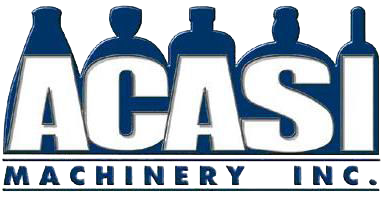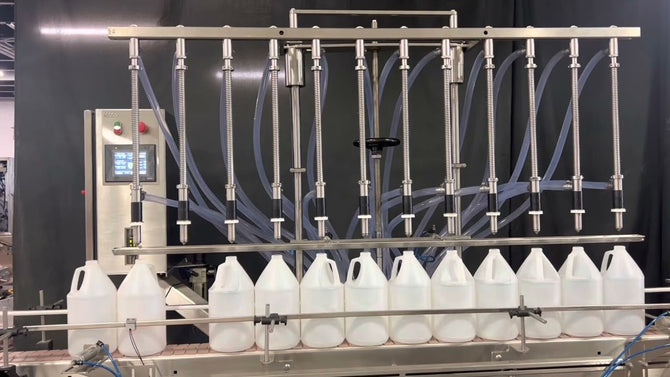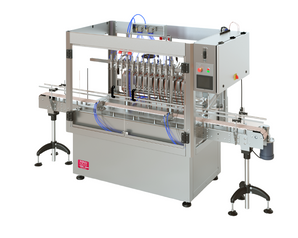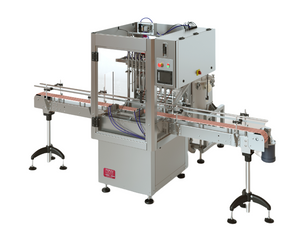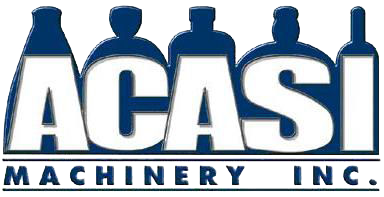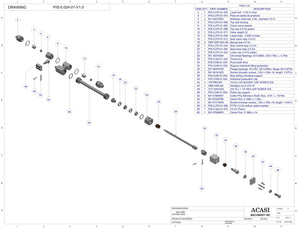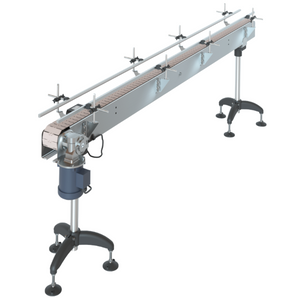Flowmeter Filling Machines
Flowmeter Technology:
There are thousands of applications and uses for flowmeters; this article will focus on the flowmeter used in bottle-filling machines.
Flowmeters measure the flow of liquid, gases, and solids through pipes, hoses, and gears.
If you measure flow in volume/time, pulses/volume, and multiply it by the time it took to fill a container, you can calculate an accurate fill volume.
For example, the flow meter measures 18 liters/minute * 3 minutes = 54 liters
Flowmeter Technology for Bottle Filling
Flowmeter filling machines are becoming more popular daily with the increase in accuracy and cost reduction of the actual flowmeter devices.
There are many technologies to fill bottles with different products. Among the most popular are:
- Piston-filling machines
- Overflow fillers
- Flowmeter fillers
- Pump fillers
- Gravity time fillers
- Peristaltic pump fillers
Flowmeter fillers have become popular because the technology offers substantial advantages for some applications.
Depending on the type of flowmeter used in the liquid filling process, the advantages and disadvantages vary; here are the most used:
Coriolis Mass Flowmeters Filling Machine
- Very accurate and repetitive flowmeter measurements: These high-precision flow measurements provide the tools to make volumetric liquid fillers that can fill from a few milliliters to a few gallons without changing pistons or other mechanical components in other bottling technologies.
- Ease of cleanability – effective CIP: Coriolis and Magnetic Flowmeters offer one of the cleanest and least obstructed ways to fill containers in the bottling industry. The Coriolis principle is very particular since it measures the behavior (amount and frequency of mechanical bends) of the tubing where the product goes through; with this design, there are no threads or mechanical obstructions. An effective CIP (Clean In Place) can be guaranteed because the product on the Coriolis flowmeters passes only through a couple of smooth polished tubes. So you can clean it by simply running the CIP solution across it.
- Can be used to fill a large variety of products: One of the main advantages of a Coriolis filling machine is the wide variety of products it can run (Since it’s a Mass Flowmeter system); the same liquid filler can run from water-thin products to medium viscosity creams or sauces. Having this flexibility makes it an excellent choice for co-packers and any bottling production facility that wants to produce several different products and wants fast changeovers and cleanup.
- The quick changeover in volume: The volume measurement is usually achieved by either counting pulses or revolutions, so adjusting volume from a small container to a larger one it’s quickly done by changing the settings on a touchscreen.
- Stability through several filling nozzles: The accuracy and repeatability achieved with Coriolis Flowmeters are evident when there is no need to make any individual adjustments to the filling nozzles. Having no individual adjustments helps to make changeovers from one product to another faster and easier.
Limitations:
- Higher viscosity: Higher viscosity products have limitations since there is a significant pressure drop to get the product through the flowmeter.
- Cost: The price for the Coriolis flowmeters is high, and the bottling equipment manufacturers need to do all the integration, pressurized tanks, or pumps to be able to run these machines adding to the cost.
Electromagnetic Flowmeters
Advantages:
- Very accurate and repetitive flowmeter measurements: These high-precision flow measurements provide the tools to make volumetric liquid fillers that can fill from a few milliliters to a few gallons without changing pistons or other mechanical components in other bottling technologies.
- Ease of cleanability – effective CIP: These flowmeters offer one of the cleanest and less obstructed ways to fill containers in the bottling industry. The Electromagnetic flowmeter measures the flow going through the piping with electrodes, and there is no effective interference of the product going through the cavity. An effective CIP (Clean In Place) can be guaranteed because the product on the Coriolis flowmeters passes only through a couple of smooth polished tubes. So you can clean it by simply running the CIP solution across it.
- Can be used to fill a wide range of electrically conducting products: One of the main advantages of the electromagnetic filling machine is the wide variety of products it can run; the same liquid filler can run from water-thin products to medium viscosity creams or sauces as long as they are electrically conductive. Having this flexibility makes it an excellent choice for co-packers and any bottling production facility that wants to produce several different products and wants fast changeovers and cleanup.
Limitations:
- High viscosity: Higher viscosity products have limitations since there is a significant pressure drop to get the product through the flowmeter.
- Cost: The price for the Electromagnetic flowmeters is high, and the bottling equipment manufacturers need to do all the integration, pressurized tanks, or pumps to be able to run these machines adding to the cost.
- Product needs to be electroconductive: If the product that needs to get bottled is not electroconductive, the flowmeter will not detect it. Therefore it will not be able to measure the flow. Considering this for every product the bottler wishes to fill at the moment or for possible future projects is essential.
Oval and Spur Gear Flowmeters
Advantages:
- Variety: There are many gear and oval gear flowmeter designs with different construction materials. Having this flexibility provides possibilities to make specific machines better adapted to particular applications
- Cost: You can find economical plastic oval gears, as well as expensive, high-end rotary positive displacement pumps that you can use according to the liquid filling application, product, particles, viscosity, and pressure, among others.
- Quick changeover in volume: When you use positive displacement pumps on filling machines, the volume adjustment is usually made by either counting pulses or revolutions, so adjusting volume from a small container to a larger one it’s quickly done by changing settings on the control panel.
Limitations:
- Accuracy: Pumps used by themselves for liquid filling machines are not as accurate as flowmeter systems but may be acceptable in bottling applications where the product is not expensive, and accuracy is not a limiting factor.
- Particles: Gear and Oval gear flowmeters can’t work with particles since they will get stuck on the teeth. However, rotary rotors with pocket design positive displacement pumps can handle particles of different sizes.
- Cleanability: In general, cleaning gear pumps is more challenging; for delicate products and changes where compatibility between the products is an issue, complete disassembly of the pump used for filling will need to occur.
- Multiple head volume variety: On a liquid filler that has multiple gear flowmeters, there is always the need to adjust the volume on each head individually; even though the gear flowmeters are almost identical and pressures are the same, adjustments are necessary, and when a volume change is needed the proportion of adjustments it’s not enough, and additional adjustments are required.
- Stability through several filling nozzles: Initial adjustment of a pump filler requires individual adjustment of each nozzle; once the machine is adjusted, it will work consistently for some time, but any change in tank volume or head pressure, ambient temperature, product temperature will cause the fill levels to vary and require constant tweaking.
Conclusion on Flow Meter Machines
There are many ways to measure the amount of liquid, pastes, and products going into containers.
Product filling into containers for every facility is different, so it’s critical to understand what technologies are a better fit for current and future needs. Considering everything discussed in this article is essential to make the best possible decision. Get pricing on all possibilities, inspect the machine, and get training at the manufacturer before the machine is shipped out.
Acasi Machinery
Our company specializes in innovative capping solutions designed to streamline and enhance your production efficiency. With a commitment to quality, we offer a wide range of capping machines tailored to meet the unique needs of industries worldwide. Backed by years of expertise, we strive to deliver reliable equipment that ensures precision and consistency in every operation.
